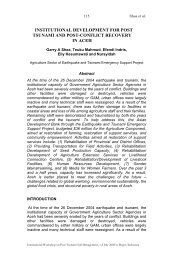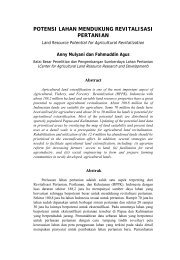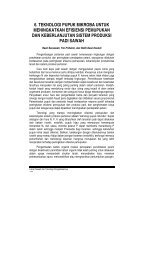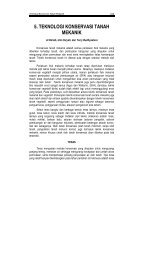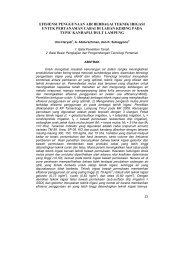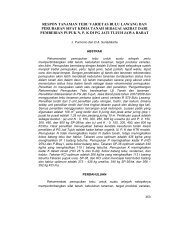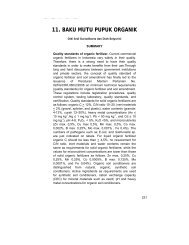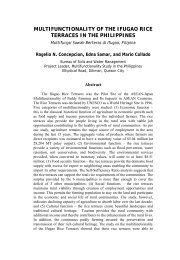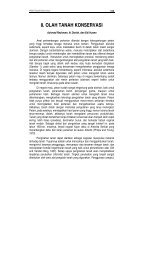Proceedings - Balai Penelitian Tanah
Proceedings - Balai Penelitian Tanah
Proceedings - Balai Penelitian Tanah
Create successful ePaper yourself
Turn your PDF publications into a flip-book with our unique Google optimized e-Paper software.
102<br />
Sembiring et al.<br />
demonstrate and evaluate soil management practices to restore the<br />
productivity of rice crop in tsunami-affected production areas, which in<br />
turn become a part of management strategies in restoring productivity<br />
to pre-tsunami levels, if not enhance it.<br />
Table 2. Rice crops production and harvested area by 2004 and 2006 in<br />
NAD<br />
Commodity Harvested<br />
area (ha)<br />
2004 2006<br />
Production<br />
(ton)<br />
Harvested<br />
area (ha)<br />
Lowland Rice 367,537 1,544,528 315,324<br />
(14%)<br />
Upland Rice 3,429 7,547 3,082<br />
(10%)<br />
Production<br />
(ton)<br />
1,335,354<br />
(14%)<br />
6.843<br />
(9%)<br />
Total 370,966 1,552,078 318,406 1,342,197<br />
Source: BPS (2007).<br />
Values in brackets are percentage reduction from 2004.<br />
Carefully planned field, as well as pot, experiments were implemented<br />
to firmly establish the actual causes and identify remedial actions and<br />
soil management practices. The trials were widely promoted as<br />
demonstration sites in order to increase understanding of the issues<br />
and adoption of mitigation strategies. Many scientific approaches and<br />
specific technologies have been constructed, tried and evaluated.<br />
There is a need to transfer the techniques and knowledge to the<br />
farmers around trial sites.<br />
Agricultural research provides the means and capacity for generating<br />
new technology to increase agricultural production. Agricultural<br />
research systems after the tsunami have a key role to play in<br />
agricultural and rural community development in NAD. To cope with<br />
problems of rice cropping after tsunami in NAD, through the ACIAR<br />
project LWR/2005/118, research systems have been developed.<br />
Capacity building through workshops and training, research and<br />
variety trials – especially on rice cropping – demonstrating crop<br />
management packages have also been conducted and evaluated in<br />
some tsunami-affected areas. The DPI-ACIAR from Australia and<br />
Indonesian Agency for Agricultural Research and Development<br />
managed the project, providing technical inputs to local agronomists,<br />
and taking responsibility for data management and communications.<br />
Replicated field experiments were conducted to evaluate technologies<br />
(varieties, soil amendments, agronomic management) to improve rice<br />
crop production and targeted to address local management issues.<br />
Demonstration trials took place in Aceh Besar, Bireuen, Pidie and<br />
International Workshop on Post Tsunami Soil Management, 1-2 July 2008 in Bogor, Indonesia



